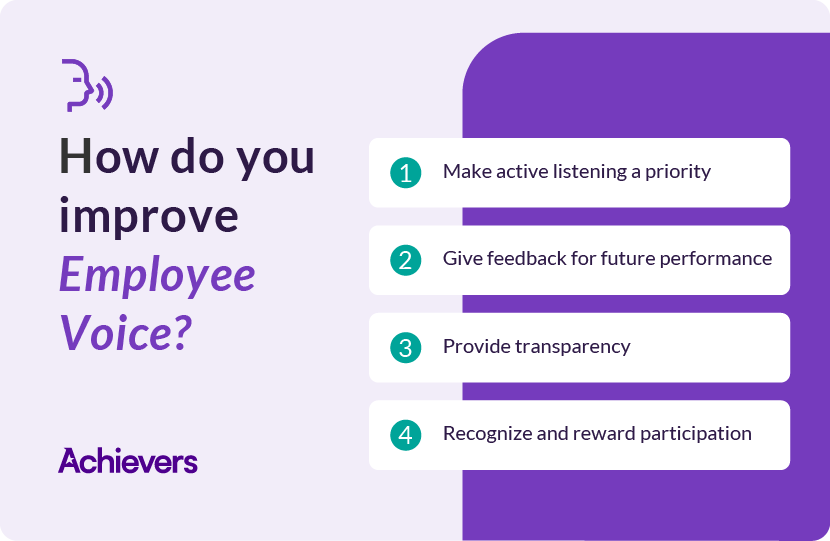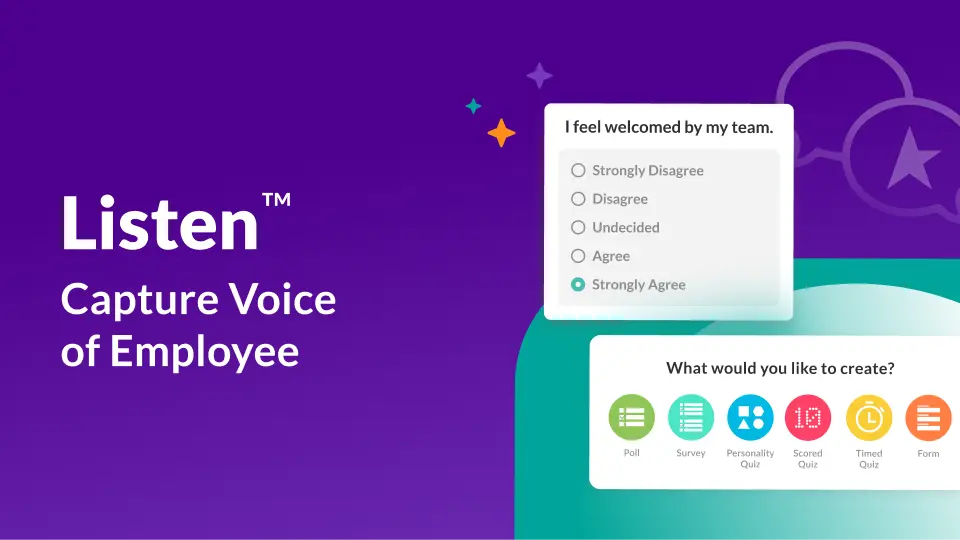Table of contents
Employee voice is a trending topic for leaders. But why? Well, according to Gallup research, only one in four employees strongly agree that their opinions matter at work and an even smaller 8% feel their employers actually act on employee feedback. This alarming disconnect reveals a significant opportunity for organizations to improve their workplace culture.
When employees feel heard and see their feedback being implemented, they are more likely to be engaged and productive. By promoting and encouraging employee voice, organizations can not only address this gap but also boost productivity, spark innovation, and increase overall engagement.
All of which brings an important question to the forefront: Are you listening to your employees? If not, it might be time to start. To help you get on top of this trend, this blog will explore what employee voice really means and how you can effectively harness it in your organization.
What is employee voice?
Employee voice, also known as Voice of the Employee (VoE), is defined as giving people opportunities to express their ideas, concerns, and perspectives with authenticity and without fear of social or workplace consequences. This concept ensures that employees have a genuine influence on decisions at work through their feedback.
Employee voice is a critical aspect of organizational behavior, encompassing the methods and systems through which employees communicate their thoughts and opinions about work-related matters. The goal is to create an environment where employees feel safe and encouraged to speak up, knowing their input will be taken seriously and can lead to meaningful changes.
Does employee voice really improve performance?
Employee voice can significantly boost organizational performance. When employees are encouraged to share their ideas, concerns, and feedback, it creates a more dynamic and responsive workplace. Here are just a few reasons why employee voice is important:
- Job satisfaction: When employees feel heard and valued, job satisfaction skyrockets. They are more likely to be motivated and committed to their roles, leading to higher productivity and better overall performance.
- Employee retention: Companies that actively listen to their employees and implement their feedback see lower turnover rates. Employees are more likely to stay with a company where their opinions matter and where they can see tangible changes resulting from their input.
- Improving employee engagement: Engaged employees are more involved and enthusiastic about their work. Promoting employee voice can boost engagement levels as employees feel more connected to their work and the company’s goals. This increased engagement translates to higher performance and better results.
How do you measure voice of the employee?
Measuring the voice of the employee is crucial for understanding employee sentiment, improving engagement, and driving organizational success. VoE refers to the collective feedback, opinions, and feelings that employees share about their workplace. Capturing this voice involves more than just periodic surveys; it requires a holistic approach to gather and analyze employee insights continuously. Here’s a solid framework for effectively measuring the voice of the employee:
- Use regular and diverse feedback mechanisms: To truly understand your employees’ perspectives, employ a mix of feedback methods. Options like pulse, engagement, and exit surveys offer a broad view, while one-on-one meetings provide personalized insights. Engage in focus groups for qualitative depth and utilize suggestion boxes for ongoing anonymous feedback. Also, don’t overlook Employee Resource Groups (ERGs) for diverse perspectives.
- Foster an open feedback culture: Creating a culture of open feedback is about more than just setting up suggestion boxes — it’s about creating an environment where every voice matters. When employees see their feedback leading to action, trust and engagement flourish. Confidentiality ensures honest input, while leadership involvement demonstrates a commitment to listening and making a difference.
- Analyze and act on feedback: Harnessing feedback isn’t just important — it’s essential for organizational growth. Start by using analytics tools to uncover trends and areas for improvement. Develop action plans based on this feedback, keeping your team informed every step of the way. Treat VoE measurement as a continuous journey, regularly adjusting strategies based on fresh feedback
Tools to measure voice of the employee
Several tools can help you measure and analyze VoE effectively. Here’s a list of some top tools:
- Achievers Listen: A comprehensive employee feedback tool that enables continuous listening through pulse surveys, feedback channels, and sentiment analysis. It helps organizations understand employee engagement and take timely action to improve workplace culture.
- Peakon: a Workday company that provides continuous employee listening through regular surveys and powerful analytics, offering insights into engagement, satisfaction, and productivity.
- Qualtrics EmployeeXM: A robust platform capturing employee feedback through surveys and other mechanisms, it offers advanced analytics empowering organizations to understand and act on employee sentiments.
- Culture Amp: An employee feedback solution featuring survey tools, analytics, and actionable insights to foster a positive workplace culture.
- TINYpulse: Specializing in real-time employee feedback through lightweight surveys, it also offers tools for recognition and performance management.
- Workleap: Combining engagement surveys with feedback and reporting tools, it enhances understanding of team dynamics and boosts employee satisfaction.
- 15Five: A performance management tool encompassing feedback, one-on-one meeting tracking, and engagement surveys to support continuous feedback and goal alignment.

How to take employee voice to the next level
Elevate your organization’s approach to employee voice by integrating these four essential components for fostering a culture of engagement and empowerment within your workforce:
1. Make active listening a priority
The power of active listening can’t be overestimated. It’s a critical skill for people leaders who believe being a coach to employees is crucial to individual success in the organization. Active listening is a technique in which the listener thoroughly absorbs, comprehends, responds, and retains what someone else is saying. The Center for Creative Leadership recommends leaders learn active listening skills to become better coaches, either for holding long conversations or short coaching moments.
The 6 elements of active listening
- Paying attention: Devote full focus to the speaker’s words and non-verbal cues.
- Withholding judgment: Refrain from forming opinions prematurely, allowing the speaker’s perspective to be fully heard.
- Reflecting: Mirror back the speaker’s words and emotions to demonstrate understanding and empathy.
- Clarifying: Seek deeper understanding by asking questions and seeking clarification on unclear points.
- Summarizing: Recap key points to ensure mutual understanding and agreement.
- Sharing: Reciprocate openness by expressing your own thoughts and feelings, fostering a balanced dialogue.
An active listener has empathy but doesn’t necessarily agree with what is being said. Actively listen to your workforce by providing an annual engagement survey won’t cut it and it’s important to adopt a more continuous listening approach to your organization. If your organization isn’t ready to fully transition from an annual engagement survey to an always-on channel yet, try adopting quarterly pulse surveys as a start.
By opening these always-on avenues atop in-person conversations, employees will feel a welcome invitation to share their feedback. Managers can also gather valuable insights that they can act on in real-time to effectively move the needle when it comes to employee engagement.
2. Give feedback for future performance
Giving employees feedback on everything from work performance to career development is a powerful engagement skill. Proper feedback can strengthen employee voice and build employee-manager trust. People only accept feedback when they believe the person giving it is interested in their welfare. It’s a psychological aspect of communication.
The catch is the performance-related feedback must be useful and forward-looking. Yes, it’s important to recognize someone for their daily wins and offer praise for team accomplishments. It’s equally important to provide performance-related feedback, which refers to employer-employee interactions focused on helping the employee improve from that point forward.
For feedback to be effective and strengthen the voice of the employee, conversations need to be personal and have two-way dialogue. Think about ways to problem solve together and empower employees to contribute their ideas and recommendations.
Ways to provide feedback to improve performance
- Be specific: Provide concrete examples and details to illustrate your feedback effectively.
- Focus on behavior: Discuss observable actions and behaviors rather than making assumptions or judgments.
- Use the “sandwich” method: Begin with positive feedback, provide constructive criticism, and end with positive reinforcement.
- Offer suggestions for improvement: Provide actionable recommendations or solutions to help the individual grow.
- Encourage dialogue: Foster an open conversation by inviting the individual to share their perspective and thoughts on the feedback.
- Be timely: Offer feedback promptly after the observed behavior or event to ensure its relevance and impact.
- Be respectful and supportive: Approach feedback with empathy and understanding, maintaining a supportive tone throughout the conversation.
Bonus tip: How can you ensure your employee feedback is valuable and making an impact? Check out 29 employee feedback examples and how to use them.
3. Provide transparency
According to Deloitte’s 2024 Global Human Capital Trend report, 86% of surveyed workers and 74% of surveyed leaders believe that emphasizing trust and transparency in the relationship between employees and the organization is very or critically important. This focus on trust and transparency becomes even more crucial in organizations where ambiguity prevails, often due to a lack of employee voice.
When employees feel unheard and are not given transparency, they are less likely to feel empowered to contribute to decision-making and offer valuable input. To address this, it is important to be thoughtful during team meetings and performance reviews, ensuring that employees are kept informed and updated. Additionally, providing avenues for anonymous feedback, such as direct surveys or always-on channels, can help employees share their concerns and feel more engaged.
Why transparency matters in the workplace
- Builds trust: Transparency fosters trust among employees, as they feel informed and included in decision-making processes.
- Enhances engagement: Employees are more engaged when they understand the reasoning behind organizational decisions and feel like valued contributors.
- Encourages accountability: Transparent communication holds individuals and teams accountable for their actions, fostering a culture of responsibility.
- Promotes alignment: Transparent communication ensures that everyone is on the same page regarding goals, expectations, and priorities, leading to better alignment and coordination.
- Fosters innovation: Openness encourages the sharing of ideas and feedback, sparking innovation and creativity within the organization.
- Improves morale: When employees feel that information is freely shared and that they have a voice, it boosts morale and job satisfaction.
- Supports retention: A transparent workplace culture helps retain top talent by demonstrating respect for employees and their contributions.
4. Recognize and reward participation
Encourage employee voice by recognizing and rewarding your employees for sharing their feedback. Show appreciation for their participation and they will most likely repeat that action again. The more you recognize and reward employees for sharing their feedback, the more they will repeat that behavior.
Moving forward, make it a habit to recognize and reward employees for participating in pulse surveys, providing their feedback, and collaborating on effective action. Employees will feel valued and motivated to continue sharing their input.
Ways to recognize and reward employee feedback
- Public acknowledgment: Highlight employees who provide valuable feedback during team meetings or company-wide communications.
- Incentives: Offer rewards such as gift cards, extra vacation days, or other perks to employees who consistently contribute feedback.
- Professional development opportunities: Provide growth and advancement opportunities to employees who actively provide feedback.
- Personalized recognition: Tailor recognition efforts to each employee’s preferences and motivations, ensuring maximum impact.
- Team celebrations: Celebrate milestones or achievements reached through employee feedback with team lunches, outings, or other group activities.
Getting down to the business of employee voice
Creating an environment where employees feel comfortable and motivated to express their ideas, concerns, and feedback is crucial for the success and growth of any organization. Employee voice not only fosters innovation and engagement but also helps in identifying potential issues before they escalate.
So, how can organizations encourage employee voice? There are numerous strategies that can be implemented to ensure that every team member feels valued and heard. Here are some effective ways to encourage employee voice:
- Solicit employee feedback through listening tools, surveys, and chatbots
- Let employees be anonymous when providing feedback or let them choose representatives who can share their concerns, suggestions, and ideas with managers
- Crowdsource decision-making
- Implement an open-door policy
- Encourage managers to hold team sessions to review employee engagement survey results, discuss top areas of success and improvements, and build an action plan together
- Hold periodic company-wide meetings led by top executives in which employees are encouraged to speak their mind and present ideas
- Respond to employee ideas and go full circle, telling each employee when the idea was presented, why it was accepted or rejected, and next steps
- Frequently recognize and reward employees for sharing their feedback
This is just a short list of ways to strengthen employee voice across your organization. Employee voice should be deeply weaved throughout all aspects of the employee experience.
Encourage your employees to speak up
Do your employees feel empowered to speak up and share their honest feedback? To effectively encourage employee voice across your workplace, you need to first build trust. However, achieving this level of employee engagement requires more than just implementing feedback mechanisms; it necessitates building trust as the foundation of your organizational culture.
When employees trust that their voices will be heard and valued, they are more likely to speak up, share their ideas, and contribute to meaningful change within the organization. By prioritizing trust-building initiatives, such as transparent communication, supportive leadership, and recognition of employee input, you can create a workplace where every voice matters.
Remember, building trust takes time and effort, but the benefits of an empowered and engaged workforce are well worth the investment. So, take the necessary steps to cultivate trust within your organization, and watch as employee voice flourishes, driving innovation, collaboration, and ultimately, organizational success.




Key insights
- Discover the meaning of employee voice, how it improves performance and how to measure it.
- Find out how 86% of surveyed workers believe that emphasizing trust and transparency in the relationship between employees and the organization is very important.
- See 4 steps to take employee voice to the next level with active listening, feedback for future performance, transparency, and recognition.

